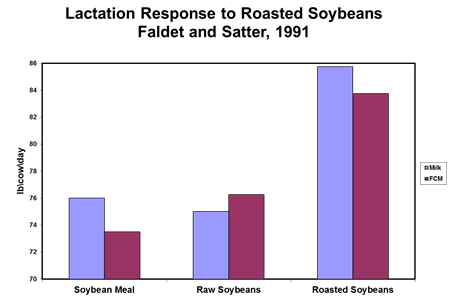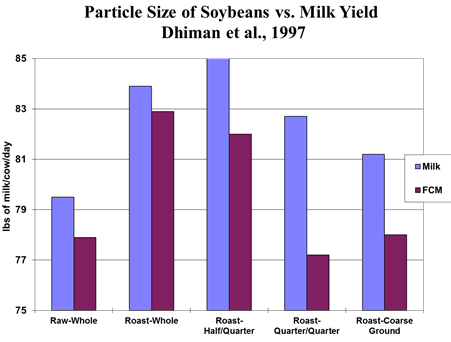
The Facts Are In…
“Large increases in milk production are possible when early lactation cows are fed properly heated soybeans. We conducted a large scale lactation study to measure milk production when soybeans were heated to 295 degrees F and steeped for 30 min. (Faldet et al., 1991) Forty-six multiparous Holstein cows were fed one of three total mixed diets from 15 to 119 d postpartum with alfalfa silage as the only forage. Each diet contained 50% forage and 50% concentrate on a DM basis. Diets were formulated to be isonitrogenous by replacing corn and solvent soybean meal with raw soybeans or heat-treated soybeans. The proportion of protein supplement in the diet on a DM basis for the three groups was 10% soybean meal, 13% raw soybeans, or 13% heat treated soybeans. The soybean meal diet was fed to all cows during week 1 and 2 postpartum for covariate adjustment of dry matter intake and milk production. Intake of DM was similar across treatments. Feeding heat-treated soybeans supported milk (9.9 lbs/d), 3.5% FCM (8.8lbs/d), and milk protein (.2lbs/d) than soybean meal or raw soybeans. Milk fat percentage was not altered by treatments. However, milk protein percentage was depressed in cows fed heat-treated soybeans compared with soybean meal (2.85 vs. 2.99%, respectively).”
“Figure 1 contains a plot of the unadjusted mean daily milk production for cows in this experiment. Cows fed the heat processed soybeans achieved a higher peak milk production and reached the peak 2 – 4 weeks later than the soybean meal group or the unheated soybean group.”
“A large number of lactation studies have been conducted with heat processed soybeans and there is little doubt that well roasted soybeans can be a very effective supplement for lactating cows, particularly when alfalfa silage or hay are the principal forage.”

